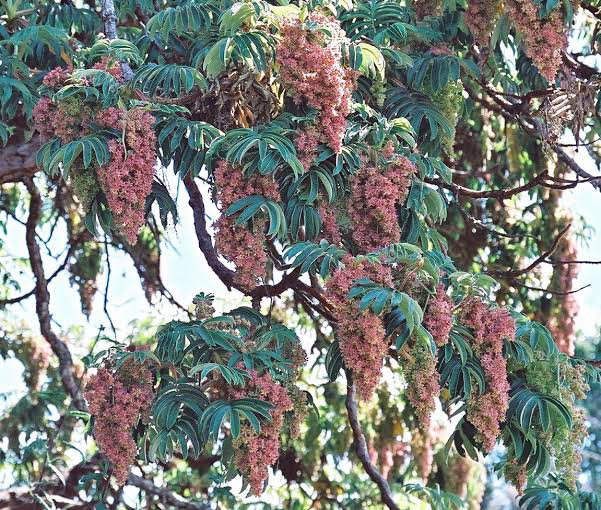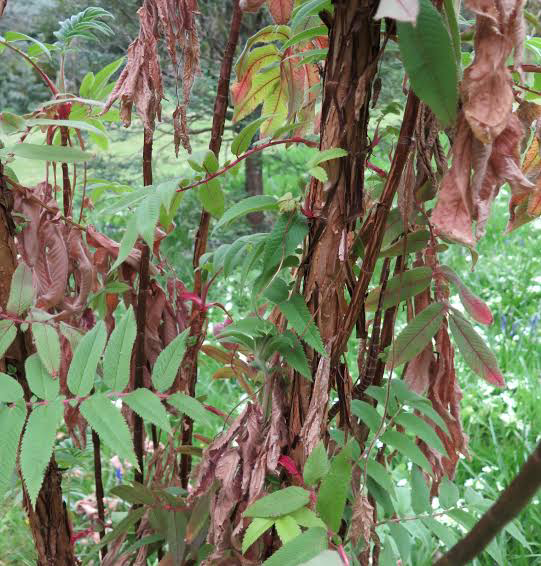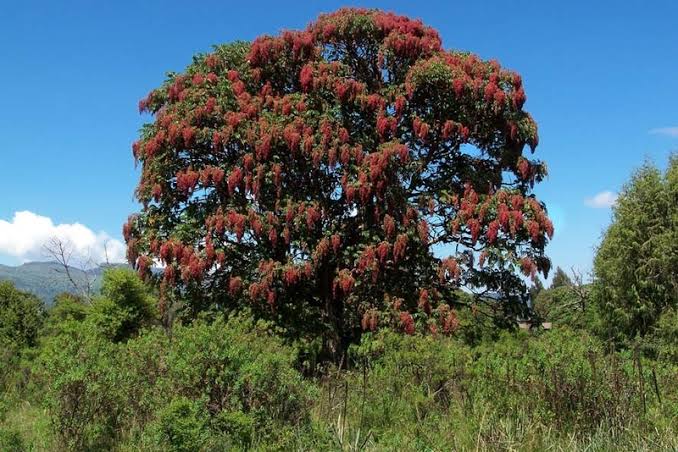The Hagenia tree, scientifically known as Hagenia abyssinica but commonly referred to as African Redwood, is a remarkable and ancient medicinal plant with a rich history of traditional use. This article will delve into the various medicinal health benefits associated with Hagenia, exploring its botanical description, historical significance, and contemporary applications in healthcare.
The history of Hagenia’s medicinal use dates back centuries, deeply intertwined with the cultures of East Africa. Indigenous communities in regions such as Ethiopia, Kenya, and Tanzania have utilized various parts of the Hagenia tree for their therapeutic properties. Here’s a glimpse into the historical significance of Hagenia:
Hagenia has been a vital component of traditional medicine in East Africa. Its bark, leaves, and roots were used by healers to treat a wide range of ailments, from digestive disorders to respiratory issues.
Beyond its medicinal applications, Hagenia played a role in cultural rituals and ceremonies. It was considered a sacred tree by some communities and featured prominently in their customs.
The powdered bark of Hagenia was applied topically to wounds and cuts due to its antiseptic properties. It helped prevent infections and promoted faster healing.
Hagenia was used as a remedy against malaria. Its leaves were brewed into a tea, which was believed to alleviate the symptoms of this debilitating disease.
In some cultures, Hagenia was associated with fertility and used to address issues related to reproductive health.
Hagenia was often planted near homes to ward off evil spirits and protect the inhabitants.
The Botanical Description of Hagenia
Understanding the botanical features of Hagenia is crucial to appreciate its diverse applications in traditional and modern medicine. Here are six key aspects of its botanical description:
1. Life: Hagenia is a perennial tree that can live for several decades, sometimes reaching heights of up to 20 meters.
2. Leaves: The leaves are pinnate, meaning they are arranged in pairs along a central stalk. They are dark green and have a glossy appearance.
3. Flowers: Hagenia produces beautiful clusters of pink to reddish-pink flowers. These blooms are not only visually appealing but also hold medicinal value.
4. Fruits: The tree bears distinctive fruits, which are small, round, and red in color. These fruits are an important part of the tree’s traditional medicinal use.
5. Bark: The bark of Hagenia is rough and often reddish-brown. It is a commonly utilized part of the plant for various medicinal preparations.
6. Habitat: Hagenia is primarily found in highland regions of East Africa, thriving at altitudes ranging from 1,800 to 3,000 meters above sea level. It prefers well-drained soils and cool, temperate climates.
The Geographic Distribution of Hagenia
Hagenia, commonly known as African Redwood, has a specific geographic distribution that plays a crucial role in its growth and availability. Here are six key points regarding the geographic distribution of Hagenia:
1. East African Highlands: Hagenia is primarily found in the highland regions of East Africa. It thrives in countries such as Ethiopia, Kenya, Tanzania, Uganda, and Rwanda.
2. Altitude Preference: This tree species exhibits a preference for high altitudes, typically growing at elevations ranging from 1,800 to 3,000 meters above sea level. The cooler temperatures and well-drained soils at these heights are ideal for its growth.
3. Specific Habitat: Hagenia is often found in montane and subalpine forests, where it forms a prominent part of the vegetation. It can be seen growing alongside other mountainous flora.
4. Regional Variations: While Hagenia’s primary range is within East Africa, there may be regional variations in its distribution due to local climate and environmental factors.
5. Vulnerability to Deforestation: Despite its adaptability to mountainous terrain, Hagenia faces threats from deforestation and habitat degradation, making conservation efforts crucial.
6. Importance in Local Ecosystems: Hagenia’s presence in these highland ecosystems has significant ecological implications, influencing soil quality, water retention, and providing habitat for various wildlife species.
The Chemical Composition of Hagenia
Understanding the chemical composition of Hagenia is essential for unlocking its medicinal potential. Here are seven key components found in Hagenia:
1. Alkaloids: Hagenia contains alkaloids, which are organic compounds with potential therapeutic effects. These compounds can have analgesic and anti-inflammatory properties.
2. Tannins: Tannins are polyphenolic compounds found in Hagenia. They contribute to its astringent taste and are known for their antioxidant properties.
3. Flavonoids: Flavonoids are a group of plant compounds found in Hagenia that have antioxidant, anti-inflammatory, and immune-boosting properties.
4. Terpenoids: Terpenoids are secondary metabolites present in Hagenia, which may have antimicrobial and anti-parasitic properties.
5. Phenolic Compounds: Phenolic compounds are abundant in Hagenia and are known for their potential in preventing oxidative damage and reducing inflammation.
6. Essential Oils: Hagenia may contain essential oils with distinct aromatic properties, which can have therapeutic applications in aromatherapy and traditional medicine.
7. Glycosides: Some glycosides may be present in Hagenia, contributing to its medicinal attributes. Glycosides can have cardioprotective and antispasmodic effects.
The Cultivation and Growth of Hagenia
Cultivating Hagenia can be a sustainable practice. Here are five key aspects related to the cultivation and growth of Hagenia:
1. Altitude Consideration: When cultivating Hagenia, it is essential to mimic its natural habitat by choosing high-altitude locations with cool temperatures.
2. Soil Requirements: Hagenia prefers well-drained soils. Loamy and sandy soils are suitable for its growth. Adequate soil nutrition is also crucial.
3. Propagation Methods: Hagenia can be propagated through seeds or cuttings. Seeds should be collected from mature trees, and cuttings should be taken from healthy branches.
4. Pruning and Maintenance: Pruning can help shape the tree and improve its overall health. Regular maintenance, including watering and protection from pests, is necessary, especially during the early stages of growth.
5. Sustainability: Sustainable cultivation practices are vital to preserve the Hagenia population. Efforts should be made to avoid overharvesting and to promote reforestation.
The Harvesting and Processing of Hagenia
The harvesting and processing of Hagenia involve several steps to harness its medicinal potential. Here are eight key points regarding these processes:
1. Bark Harvesting: The bark of Hagenia is a valuable part of the plant for medicinal use. It should be harvested carefully to avoid damaging the tree. Only a portion of the bark is removed, leaving the tree to regenerate.
2. Drying: After harvesting, the bark is typically dried in the shade to preserve its chemical constituents. Care must be taken to prevent contamination.
3. Powdering: Once dried, the bark is often ground into a fine powder. This powder is used in various traditional preparations, such as teas and poultices.
4. Leaf Collection: Hagenia leaves can also be collected and dried for medicinal use, particularly in the form of teas or extracts.
5. Ethnobotanical Knowledge: The processing of Hagenia often relies on traditional knowledge and practices passed down through generations.
6. Modern Research: Contemporary research methods are increasingly being employed to analyze the chemical composition and optimize the processing of Hagenia for medicinal applications.
7. Quality Control: To ensure the efficacy and safety of Hagenia-based products, quality control measures should be in place during processing.
8. Sustainable Practices: Sustainable harvesting and processing are critical to protect the Hagenia population and maintain its availability for future generations.
Read Also: 15 Medicinal Health Benefits Of Sabatia campestris (Field Rose Gentian)
The Medicinal Health Benefits Of Hagenia (African Redwood)

Hagenia, also known as African Redwood, offers a range of medicinal health benefits due to its chemical composition and traditional uses. Here are 15 of its notable health benefits:
1. Anti-Inflammatory Properties: Compounds in Hagenia may help reduce inflammation, making it useful for conditions like arthritis.
2. Analgesic Effects: Hagenia has been traditionally used to alleviate pain, offering relief from various discomforts.
3. Antipyretic Action: It can help reduce fever, making it a potential remedy for febrile illnesses.
4. Antioxidant Power: Hagenia’s antioxidants may help combat free radicals and oxidative stress in the body.
5. Anti-Malarial Properties: Traditional usage includes Hagenia as a treatment for malaria due to its potential antimalarial effects.
6. Respiratory Health: It is used to address respiratory issues such as coughs, bronchitis, and asthma.
7. Gastrointestinal Relief: Hagenia has been employed to soothe digestive problems, including diarrhea and stomach cramps.
8. Wound Healing: Topical applications of Hagenia preparations may aid in wound healing.
9. Immune Boost: It may enhance the immune system’s response to infections.
10. Cardiovascular Support: Some compounds in Hagenia could promote heart health by reducing cholesterol levels.
11. Menstrual Regulation: Traditional medicine uses Hagenia for regulating menstrual cycles and alleviating associated discomfort.
12. Antimicrobial Action: It may have antimicrobial properties, helping to combat bacterial and fungal infections.
13. Antispasmodic Effects: Hagenia may help relax muscles and relieve spasms, making it useful for various conditions.
14. Stress Reduction: Some individuals use Hagenia to reduce stress and promote relaxation.
15. Traditional Rituals: Beyond its medicinal uses, Hagenia plays a role in cultural rituals and ceremonies, promoting overall well-being.
The Methods of Usage to Achieve the Provided Health Benefits Of Hagenia (African Redwood)
To harness the health benefits of Hagenia, various methods of usage have been employed over time. Here are six common ways to achieve these benefits:
1. Herbal Infusions: Hagenia bark or leaves can be infused in hot water to make herbal teas. These teas are consumed to address various health concerns.
2. Topical Applications: Hagenia paste or poultices can be applied externally to wounds, bruises, or inflamed areas for local relief.
3. Tinctures and Extracts: Preparations like tinctures and extracts are used to concentrate the medicinal compounds for specific health applications.
4. Steam Inhalation: Inhaling steam infused with Hagenia extracts can help alleviate respiratory issues.
5. Dietary Supplements: Hagenia supplements, in the form of capsules or tablets, are available for those seeking its health benefits in a convenient format.
6. Traditional Practices: In some cultures, traditional healers incorporate Hagenia into rituals, often combining its use with spiritual elements for holistic well-being.
The Side Effects Of Using Hagenia Medicinal Plant
While Hagenia offers various health benefits, it’s essential to be aware of potential side effects and contraindications. Here are eight side effects associated with the use of Hagenia:
1. Allergic Reactions: Some individuals may be allergic to Hagenia and could experience skin rashes, itching, or respiratory symptoms.
2. Gastrointestinal Upset: Excessive consumption of Hagenia preparations can lead to digestive discomfort, including nausea and diarrhea.
3. Blood Pressure Changes: Hagenia may influence blood pressure, so individuals with hypertension should use it cautiously.
4. Pregnancy and Lactation: Pregnant and breastfeeding women should avoid Hagenia due to its potential effects on uterine contractions and the developing fetus.
5. Drug Interactions: Hagenia may interact with certain medications, so it’s advisable to consult a healthcare professional if you’re taking prescription drugs.
6. Liver Toxicity: Prolonged or excessive use of Hagenia may pose a risk of liver toxicity, so moderation is key.
7. Photosensitivity: Some individuals may experience increased sensitivity to sunlight when using Hagenia.
8. Neurological Effects: In rare cases, excessive use of Hagenia may lead to neurological symptoms, including tremors and confusion.
Read Also: 13 Medicinal Health Benefits of Paeonia Rockii (Paeonia Rockii)
Scientific Research and Studies of Hagenia

Scientific research into Hagenia has expanded our understanding of its potential health benefits. Here are eight notable findings from scientific studies:
1. Anti-Inflammatory Effects: Studies have shown that Hagenia extracts possess anti-inflammatory properties, which may be beneficial for conditions like arthritis.
2. Antimicrobial Activity: Hagenia has demonstrated antimicrobial activity against various pathogens, indicating its potential in fighting infections.
3. Antioxidant Capacity: Research has confirmed the antioxidant capacity of Hagenia, suggesting its role in combating oxidative stress.
4. Anti-Malarial Potential: Scientific investigations have supported the traditional use of Hagenia as an anti-malarial agent.
5. Immunomodulatory Effects: Some studies suggest that Hagenia may modulate the immune system, potentially enhancing its response to infections.
6. Cardiovascular Health: Research has explored the cardiovascular benefits of Hagenia, including its impact on cholesterol levels and heart health.
7. Phytochemical Analysis: Chemical analysis has identified various bioactive compounds in Hagenia, contributing to its medicinal properties.
8. Safety Profiles: Scientific studies have contributed to our understanding of the safety and toxicity thresholds of Hagenia, helping establish appropriate usage guidelines.
Safety Precautions and Recommendations In Using Hagenia Medicinal Plant
When using Hagenia for its medicinal properties, it’s crucial to take safety precautions to ensure its proper and safe utilization. Here are seven recommendations:
1. Consult a Healthcare Professional: Before incorporating Hagenia into your health regimen, consult with a qualified healthcare practitioner, especially if you have pre-existing medical conditions or are taking medications.
2. Dosage Guidelines: Adhere to recommended dosage guidelines provided by healthcare professionals or traditional healers. Avoid excessive consumption.
3. Allergy Testing: If you’re using Hagenia for the first time, perform an allergy test by applying a small amount of the preparation to a small patch of skin to check for adverse reactions.
4. Monitor for Side Effects: Keep a watchful eye for any side effects such as gastrointestinal discomfort, skin reactions, or changes in blood pressure.
5. Avoid During Pregnancy and Lactation: Pregnant and breastfeeding women should avoid Hagenia due to potential effects on uterine contractions and the developing fetus.
6. Be Cautious with Children: Use Hagenia cautiously with children and in lower doses, as their sensitivity may differ from adults.
7. Seek Immediate Medical Attention: If you experience severe allergic reactions, unusual side effects, or any adverse symptoms after using Hagenia, seek immediate medical attention.
Legal Status and Regulations In Using Hagenia Medicinal Plant
The legal status and regulations regarding the use of Hagenia may vary by region. Here are six considerations related to its legal status and regulations:
1. Protected Species: In some areas, Hagenia may be a protected species due to its ecological importance. Harvesting and use may be subject to restrictions.
2. Traditional Use: Hagenia’s traditional use may be legally recognized and protected as part of indigenous cultural heritage.
3. Herbal Medicine Regulations: Depending on the country, Hagenia may be subject to herbal medicine regulations, including quality control and safety standards.
4. Controlled Substances: Some compounds in Hagenia may be controlled substances in certain regions due to their potential psychoactive effects.
5. Import and Export Restrictions: International trade in Hagenia or its products may be regulated to protect natural populations.
6. Certification Programs: Some regions may have certification programs to promote sustainable harvesting and processing practices.
FAQs About Hagenia Medicinal Plant
Here are 18 frequently asked questions (FAQs) about Hagenia, also known as African Redwood, and its medicinal properties:
1. What is Hagenia, and what are its common names?
Hagenia, scientifically known as Hagenia abyssinica, is commonly referred to as African Redwood.
2. Where is Hagenia found geographically?
Hagenia is primarily found in the highland regions of East Africa, including Ethiopia, Kenya, Tanzania, Uganda, and Rwanda.
3. What are the traditional uses of Hagenia?
Traditional uses include treating various ailments such as pain, fever, respiratory issues, and digestive problems.
4. What are the key chemical constituents of Hagenia?
Hagenia contains alkaloids, tannins, flavonoids, terpenoids, phenolic compounds, essential oils, and glycosides.
5. How is Hagenia typically prepared for medicinal use?
Hagenia can be prepared as herbal infusions, topical applications, tinctures, extracts, steam inhalations, dietary supplements, and in traditional rituals.
6. Are there any side effects associated with Hagenia use?
Yes, potential side effects include allergies, gastrointestinal discomfort, blood pressure changes, and photosensitivity, among others.
7. Can Hagenia be used during pregnancy and lactation?
It is generally advised to avoid Hagenia during pregnancy and breastfeeding due to potential effects on uterine contractions and the developing fetus.
8. Does Hagenia interact with medications?
Hagenia may interact with certain medications, so it’s essential to consult a healthcare professional if you’re taking prescription drugs.
9. Is there scientific research on the medicinal properties of Hagenia?
Yes, scientific studies have explored its anti-inflammatory, antimicrobial, antioxidant, and anti-malarial properties, among others.
10. Are there any legal restrictions on using Hagenia?
Legal status and regulations vary by region. Hagenia may be protected, subject to herbal medicine regulations, or have import/export restrictions.
11. How can I ensure the sustainability of Hagenia use?
Practice sustainable harvesting, adhere to local regulations, and support conservation efforts to protect Hagenia populations.
12. Can Hagenia be used for children?
Hagenia should be used cautiously with children and in lower doses, as their sensitivity may differ from adults.
13. Are there any known contraindications for Hagenia use?
Individuals with allergies to Hagenia or its components should avoid its use. It should also be used cautiously with certain medical conditions.
14. Can Hagenia be used for stress relief?
Some individuals use Hagenia to reduce stress and promote relaxation, but its efficacy varies among individuals.
15. What is the role of Hagenia in traditional rituals and ceremonies?
Hagenia is considered a sacred tree by some cultures and features prominently in their customs and rituals.
16. Can Hagenia be grown outside of its native habitat?
It can be cultivated in suitable high-altitude environments with well-drained soils, mimicking its natural habitat.
17. Is Hagenia an endangered species?
The status of Hagenia varies by region, but conservation efforts are in place to protect its populations.
18. Where can I find Hagenia-based products or supplements?
Hagenia-based products and supplements can often be found in herbal stores or through reputable online retailers.

